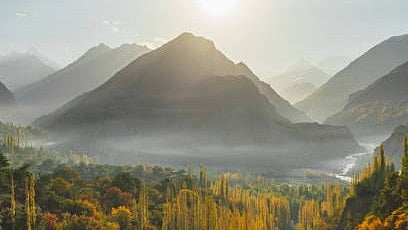
Silent Valley gets its name from missing Cicadas (the superfamily of insects) that emphasise their presence in the valley. (Representative image)
Credit: iStock Photo
Located in the rich biodiversity of the Nilgiris Biosphere Reserve, the Silent Valley National Park is a World Heritage Site and is one of the last undisturbed tracts of Southwestern Ghats Mountain rainforests and tropical moist evergreen forest in India and home to some rare species of flora and fauna.
It became the focus of one of the fiercest environmental agitations when, in 1973, the Kerala State Electricity Board announced plans to implement the Silent Valley Hydro Electric Project centred across the Kunthipuzha River.
The result would have been a disaster as the
resulting reservoir would have flooded 8.3 km of virgin rainforest and
threatened the lion-tailed macaque. The Silent Valley is home to the largest
population of lion-tailed macaques.
Long before the internet and social media, a remarkable people’s movement saved this pristine evergreen forest from being destroyed by a hydroelectric project.
The ‘Save Silent Valley’ campaign became one of the most intense agitations that raged for over 10 years and involved thousands of people from all walks of life across the country. The sustained pressure exerted on the government by citizens using every possible means available at that time — letters to the editor, seminars, widespread awareness campaigns, and petitions and appeals in courts proved ultimately successful and in 1986, Silent Valley was declared a National Park.
Upon visiting the park, a comfortable bus was waiting for us at the Silent Valley office along with a young forest guide in fatigues. The park has a core area of 89.52 km and a buffer zone of 148 km. The park, bordered by Kerala’s Mannarkad and Nilambur taluks, and Tamil Nadu’s Nilgiri district, has a stronger Tamil influence, informed the guide.
We passed tribal fields where millets were cultivated, and forest produce like honey was gathered. Tribal hamlets dotted the landscape, with the locals going about their daily lives, seemingly unfazed by the presence of wild animals such as elephants, leopards, and tigers. The guide reassured us that there had never been incidents of wild animals harming the tribals, demonstrating peaceful coexistence between humans and wildlife.
The drive through the dense evergreen forest was spectacular, with towering teak, sal, and other trees. We passed beautiful waterfalls, their crystal-clear waters cascading down the mountainside. Despite the temptation to stop, the guide warned us of the potential danger from wild animals and advised against lingering.
At the valley’s summit, we were treated to a breathtaking panoramic view of the surrounding mountains. Below, the Kunthipuzha River flowed peacefully, a reminder of the region’s beauty, and a source of the environmental struggle that had saved it.
A four-storey observation tower offered even more stunning views, including the two ranges that the proposed dam would have connected. The sight of the lush forests and mountains, untouched by the project, filled us with gratitude for the campaign that preserved them for future generations.
The majestic mountain ranges and the lush green of the silent forests around made one feel truly grateful to the people who had managed to save them for posterity.